FIAT DUCATO BASE CAMPER 2018 Owner handbook (in English)
Manufacturer: FIAT, Model Year: 2018, Model line: DUCATO BASE CAMPER, Model: FIAT DUCATO BASE CAMPER 2018Pages: 304, PDF Size: 14.93 MB
Page 101 of 304
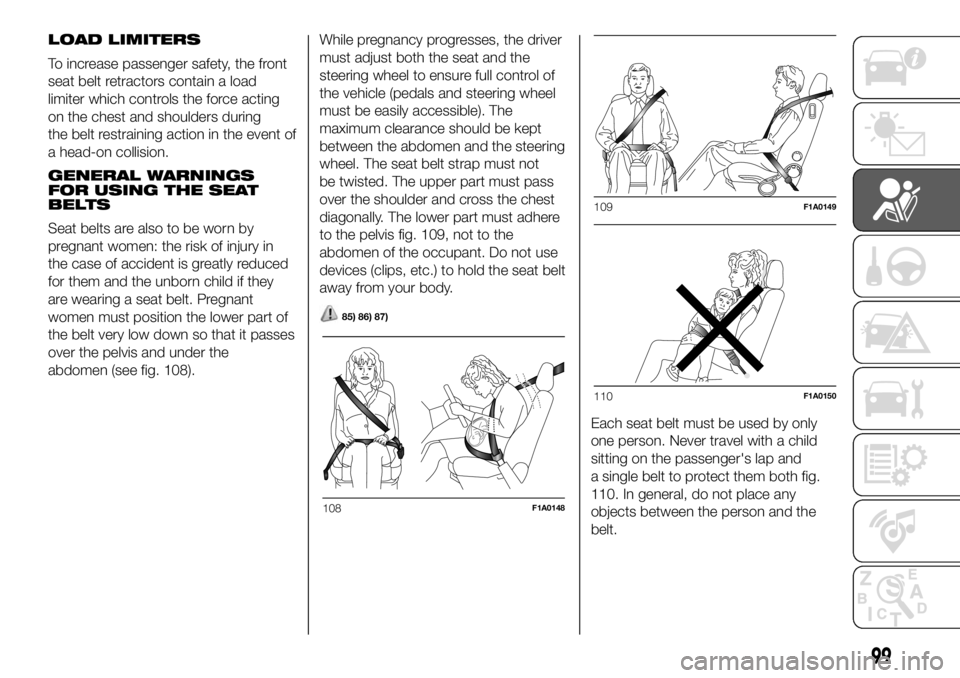
LOAD LIMITERS
To increase passenger safety, the front
seat belt retractors contain a load
limiter which controls the force acting
on the chest and shoulders during
the belt restraining action in the event of
a head-on collision.
GENERAL WARNINGS
FOR USING THE SEAT
BELTS
Seat belts are also to be worn by
pregnant women: the risk of injury in
the case of accident is greatly reduced
for them and the unborn child if they
are wearing a seat belt. Pregnant
women must position the lower part of
the belt very low down so that it passes
over the pelvis and under the
abdomen (see fig. 108).While pregnancy progresses, the driver
must adjust both the seat and the
steering wheel to ensure full control of
the vehicle (pedals and steering wheel
must be easily accessible). The
maximum clearance should be kept
between the abdomen and the steering
wheel. The seat belt strap must not
be twisted. The upper part must pass
over the shoulder and cross the chest
diagonally. The lower part must adhere
to the pelvis fig. 109, not to the
abdomen of the occupant. Do not use
devices (clips, etc.) to hold the seat belt
away from your body.
85) 86) 87)
Each seat belt must be used by only
one person. Never travel with a child
sitting on the passenger's lap and
a single belt to protect them both fig.
110. In general, do not place any
objects between the person and the
belt.
108F1A0148
109F1A0149
110F1A0150
99
Page 102 of 304
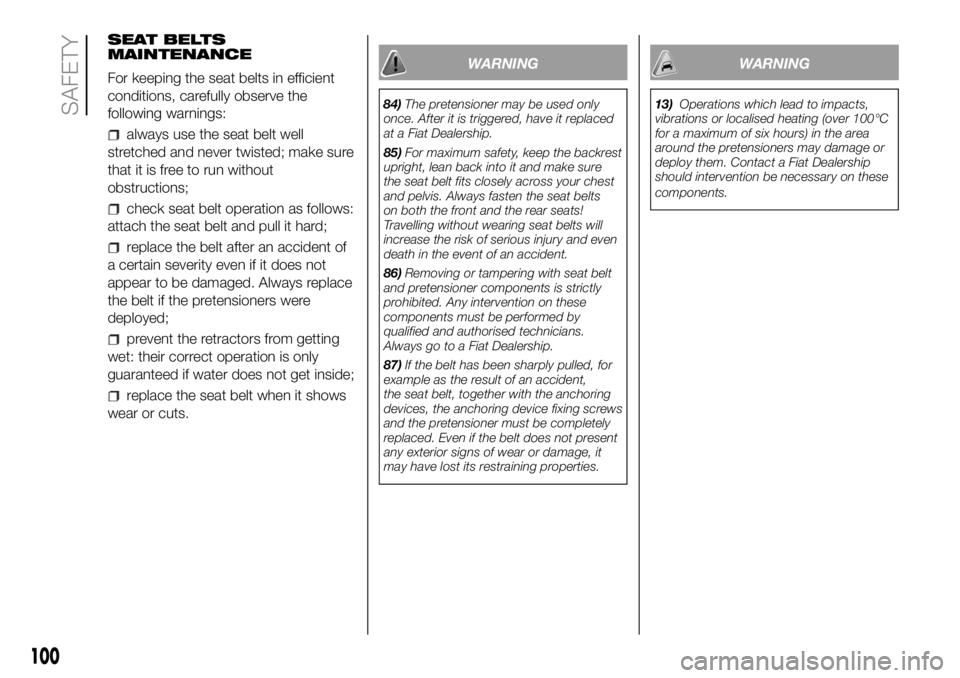
SEAT BELTS
MAINTENANCE
For keeping the seat belts in efficient
conditions, carefully observe the
following warnings:
always use the seat belt well
stretched and never twisted; make sure
that it is free to run without
obstructions;
check seat belt operation as follows:
attach the seat belt and pull it hard;
replace the belt after an accident of
a certain severity even if it does not
appear to be damaged. Always replace
the belt if the pretensioners were
deployed;
prevent the retractors from getting
wet: their correct operation is only
guaranteed if water does not get inside;
replace the seat belt when it shows
wear or cuts.
WARNING
84)The pretensioner may be used only
once. After it is triggered, have it replaced
at a Fiat Dealership.
85)For maximum safety, keep the backrest
upright, lean back into it and make sure
the seat belt fits closely across your chest
and pelvis. Always fasten the seat belts
on both the front and the rear seats!
Travelling without wearing seat belts will
increase the risk of serious injury and even
death in the event of an accident.
86)Removing or tampering with seat belt
and pretensioner components is strictly
prohibited. Any intervention on these
components must be performed by
qualified and authorised technicians.
Always go to a Fiat Dealership.
87)If the belt has been sharply pulled, for
example as the result of an accident,
the seat belt, together with the anchoring
devices, the anchoring device fixing screws
and the pretensioner must be completely
replaced. Even if the belt does not present
any exterior signs of wear or damage, it
may have lost its restraining properties.
WARNING
13)Operations which lead to impacts,
vibrations or localised heating (over 100°C
for a maximum of six hours) in the area
around the pretensioners may damage or
deploy them. Contact a Fiat Dealership
should intervention be necessary on these
components.
100
SAFETY
Page 103 of 304
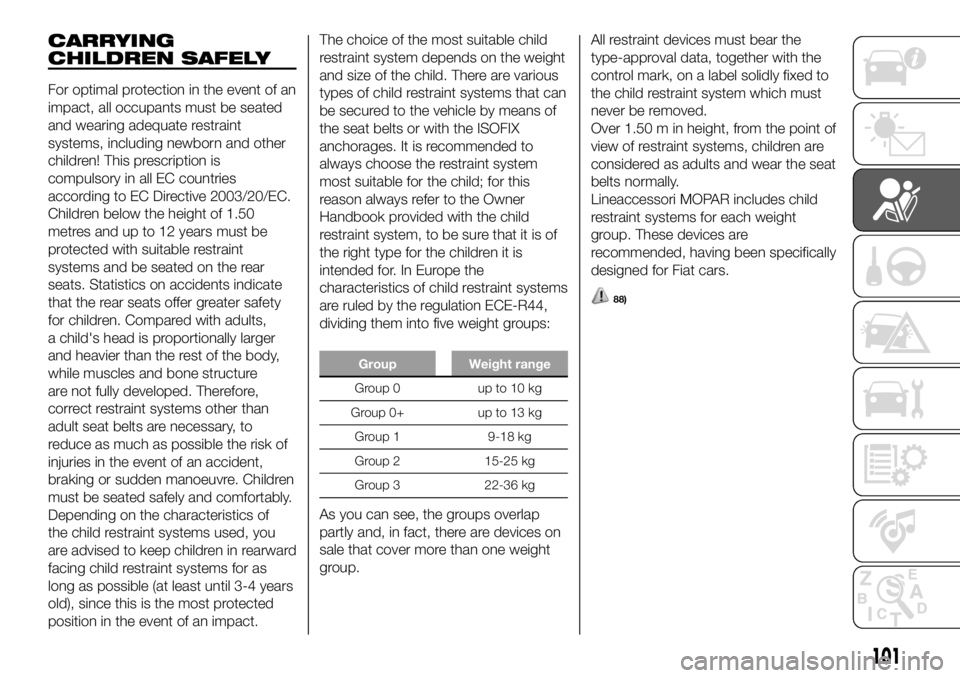
CARRYING
CHILDREN SAFELY
For optimal protection in the event of an
impact, all occupants must be seated
and wearing adequate restraint
systems, including newborn and other
children! This prescription is
compulsory in all EC countries
according to EC Directive 2003/20/EC.
Children below the height of 1.50
metres and up to 12 years must be
protected with suitable restraint
systems and be seated on the rear
seats. Statistics on accidents indicate
that the rear seats offer greater safety
for children. Compared with adults,
a child's head is proportionally larger
and heavier than the rest of the body,
while muscles and bone structure
are not fully developed. Therefore,
correct restraint systems other than
adult seat belts are necessary, to
reduce as much as possible the risk of
injuries in the event of an accident,
braking or sudden manoeuvre. Children
must be seated safely and comfortably.
Depending on the characteristics of
the child restraint systems used, you
are advised to keep children in rearward
facing child restraint systems for as
long as possible (at least until 3-4 years
old), since this is the most protected
position in the event of an impact.The choice of the most suitable child
restraint system depends on the weight
and size of the child. There are various
types of child restraint systems that can
be secured to the vehicle by means of
the seat belts or with the ISOFIX
anchorages. It is recommended to
always choose the restraint system
most suitable for the child; for this
reason always refer to the Owner
Handbook provided with the child
restraint system, to be sure that it is of
the right type for the children it is
intended for. In Europe the
characteristics of child restraint systems
are ruled by the regulation ECE-R44,
dividing them into five weight groups:
Group Weight range
Group0 upto10kg
Group 0+ up to 13 kg
Group 1 9-18 kg
Group 2 15-25 kg
Group 3 22-36 kg
As you can see, the groups overlap
partly and, in fact, there are devices on
sale that cover more than one weight
group.All restraint devices must bear the
type-approval data, together with the
control mark, on a label solidly fixed to
the child restraint system which must
never be removed.
Over 1.50 m in height, from the point of
view of restraint systems, children are
considered as adults and wear the seat
belts normally.
Lineaccessori MOPAR includes child
restraint systems for each weight
group. These devices are
recommended, having been specifically
designed for Fiat cars.
88)
101
Page 104 of 304
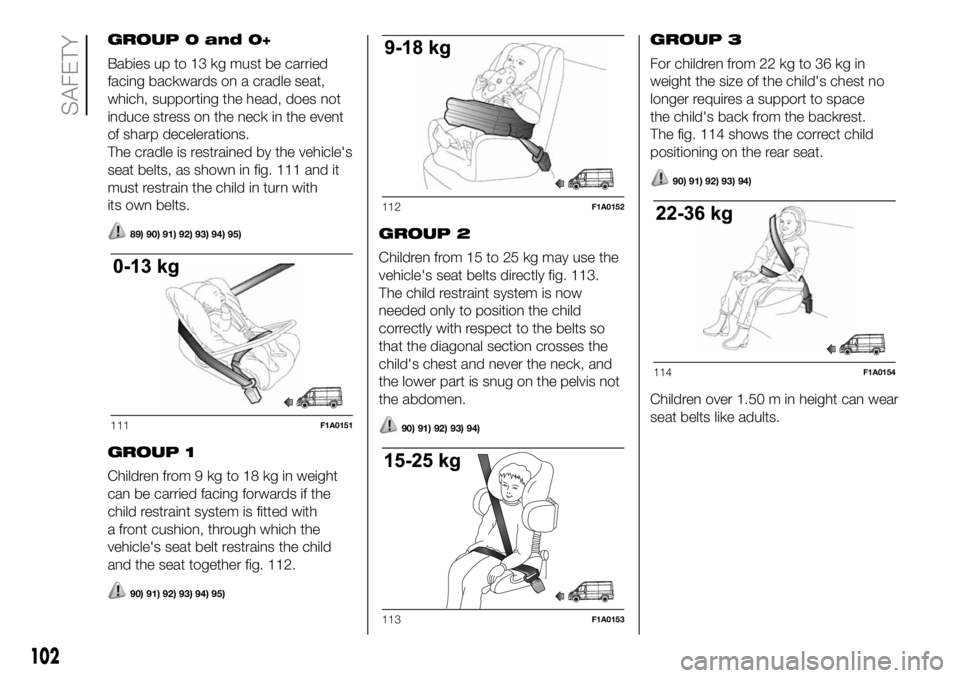
GROUP 0 and 0+
Babies up to 13 kg must be carried
facing backwards on a cradle seat,
which, supporting the head, does not
induce stress on the neck in the event
of sharp decelerations.
The cradle is restrained by the vehicle's
seat belts, as shown in fig. 111 and it
must restrain the child in turn with
its own belts.
89) 90) 91) 92) 93) 94) 95)
GROUP 1
Children from 9 kg to 18 kg in weight
can be carried facing forwards if the
child restraint system is fitted with
a front cushion, through which the
vehicle's seat belt restrains the child
and the seat together fig. 112.
90) 91) 92) 93) 94) 95)
GROUP 2
Children from 15 to 25 kg may use the
vehicle's seat belts directly fig. 113.
The child restraint system is now
needed only to position the child
correctly with respect to the belts so
that the diagonal section crosses the
child's chest and never the neck, and
the lower part is snug on the pelvis not
the abdomen.
90) 91) 92) 93) 94)
GROUP 3
For children from 22 kg to 36 kg in
weight the size of the child's chest no
longer requires a support to space
the child's back from the backrest.
The fig. 114 shows the correct child
positioning on the rear seat.
90) 91) 92) 93) 94)
Children over 1.50 m in height can wear
seat belts like adults.
111F1A0151
112F1A0152
113F1A0153
114F1A0154
102
SAFETY
Page 105 of 304
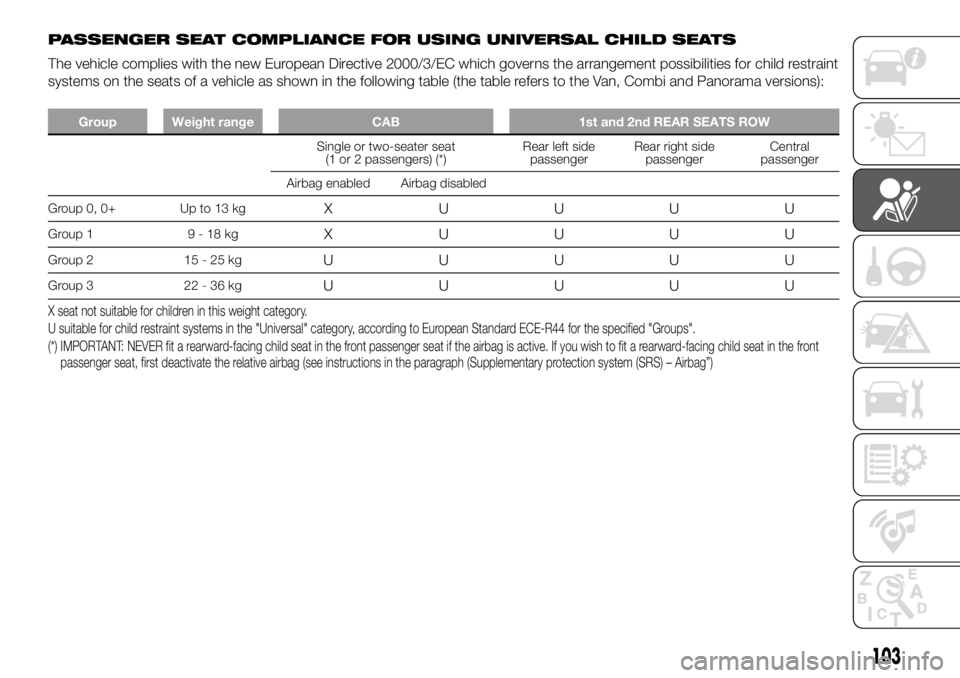
PASSENGER SEAT COMPLIANCE FOR USING UNIVERSAL CHILD SEATS
The vehicle complies with the new European Directive 2000/3/EC which governs the arrangement possibilities for child restraint
systems on the seats of a vehicle as shown in the following table (the table refers to the Van, Combi and Panorama versions):
Group Weight range CAB 1st and 2nd REAR SEATS ROW
Single or two-seater seat
(1 or 2 passengers) (*)Rear left side
passengerRear right side
passengerCentral
passenger
Airbag enabled Airbag disabled
Group 0, 0+ Up to 13 kg
X UUUU
Group 1 9 - 18 kgX UUUU
Group 2 15 - 25 kgUUUUU
Group 3 22 - 36 kgUUUUU
X seat not suitable for children in this weight category.
U suitable for child restraint systems in the "Universal" category, according to European Standard ECE-R44 for the specified "Groups".
(*) IMPORTANT: NEVER fit a rearward-facing child seat in the front passenger seat if the airbag is active. If you wish to fit a rearward-facing child seat in the front
passenger seat, first deactivate the relative airbag (see instructions in the paragraph (Supplementary protection system (SRS) – Airbag”)
103
Page 106 of 304
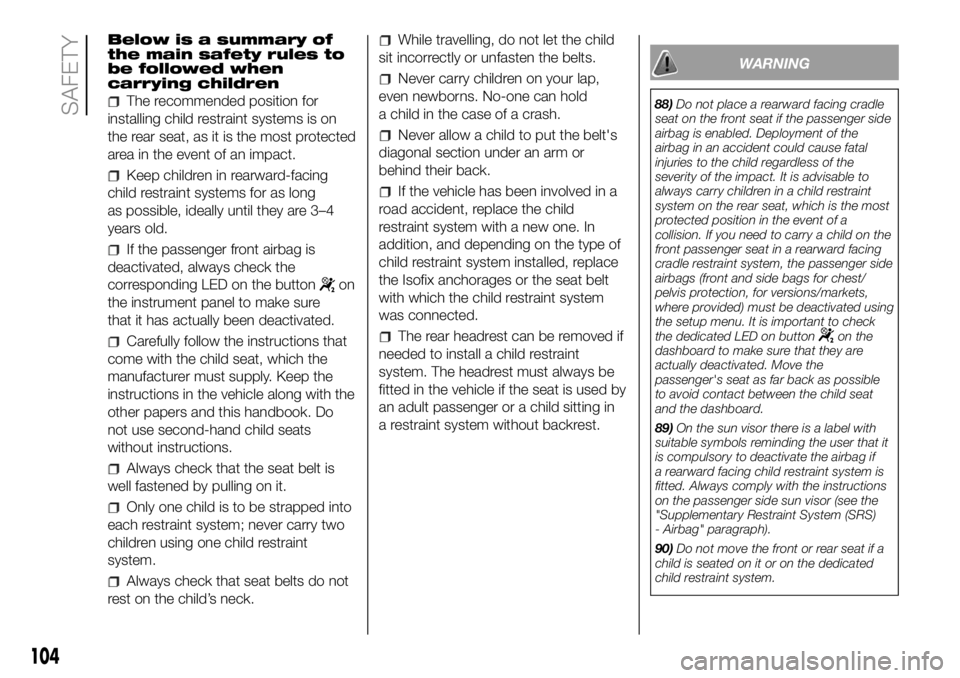
Below is a summary of
the main safety rules to
be followed when
carrying children
The recommended position for
installing child restraint systems is on
the rear seat, as it is the most protected
area in the event of an impact.
Keep children in rearward-facing
child restraint systems for as long
as possible, ideally until they are 3–4
years old.
If the passenger front airbag is
deactivated, always check the
corresponding LED on the button
on
the instrument panel to make sure
that it has actually been deactivated.
Carefully follow the instructions that
come with the child seat, which the
manufacturer must supply. Keep the
instructions in the vehicle along with the
other papers and this handbook. Do
not use second-hand child seats
without instructions.
Always check that the seat belt is
well fastened by pulling on it.
Only one child is to be strapped into
each restraint system; never carry two
children using one child restraint
system.
Always check that seat belts do not
rest on the child’s neck.
While travelling, do not let the child
sit incorrectly or unfasten the belts.
Never carry children on your lap,
even newborns. No-one can hold
a child in the case of a crash.
Never allow a child to put the belt's
diagonal section under an arm or
behind their back.
If the vehicle has been involved in a
road accident, replace the child
restraint system with a new one. In
addition, and depending on the type of
child restraint system installed, replace
the Isofix anchorages or the seat belt
with which the child restraint system
was connected.
The rear headrest can be removed if
needed to install a child restraint
system. The headrest must always be
fitted in the vehicle if the seat is used by
an adult passenger or a child sitting in
a restraint system without backrest.
WARNING
88)Do not place a rearward facing cradle
seat on the front seat if the passenger side
airbag is enabled. Deployment of the
airbag in an accident could cause fatal
injuries to the child regardless of the
severity of the impact. It is advisable to
always carry children in a child restraint
system on the rear seat, which is the most
protected position in the event of a
collision. If you need to carry a child on the
front passenger seat in a rearward facing
cradle restraint system, the passenger side
airbags (front and side bags for chest/
pelvis protection, for versions/markets,
where provided) must be deactivated using
the setup menu. It is important to check
the dedicated LED on button
on the
dashboard to make sure that they are
actually deactivated. Move the
passenger's seat as far back as possible
to avoid contact between the child seat
and the dashboard.
89)On the sun visor there is a label with
suitable symbols reminding the user that it
is compulsory to deactivate the airbag if
a rearward facing child restraint system is
fitted. Always comply with the instructions
on the passenger side sun visor (see the
"Supplementary Restraint System (SRS)
- Airbag" paragraph).
90)Do not move the front or rear seat if a
child is seated on it or on the dedicated
child restraint system.
104
SAFETY
Page 107 of 304
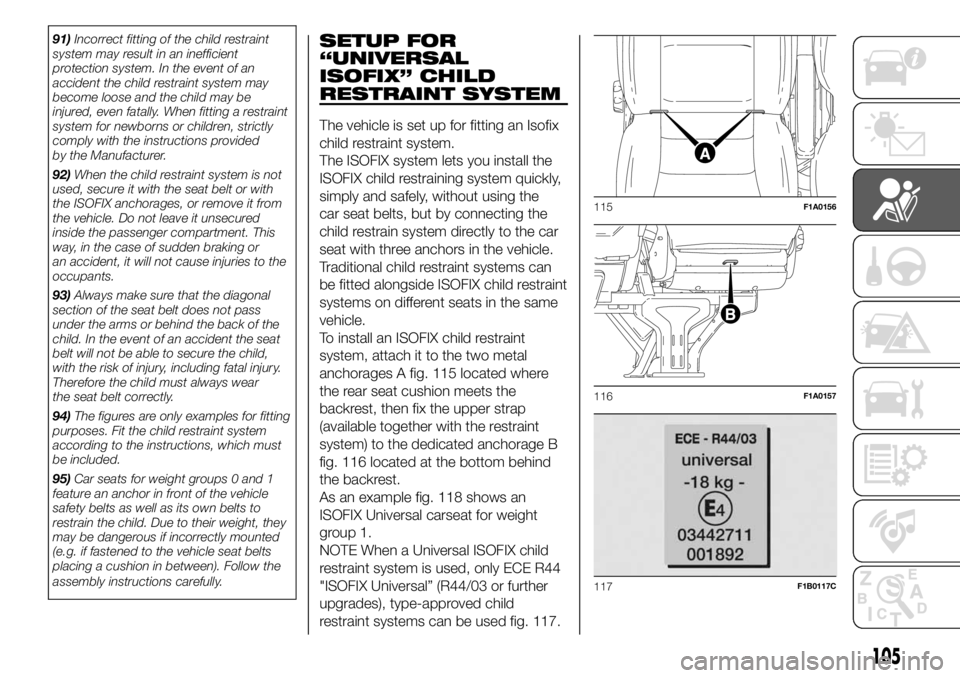
91)Incorrect fitting of the child restraint
system may result in an inefficient
protection system. In the event of an
accident the child restraint system may
become loose and the child may be
injured, even fatally. When fitting a restraint
system for newborns or children, strictly
comply with the instructions provided
by the Manufacturer.
92)When the child restraint system is not
used, secure it with the seat belt or with
the ISOFIX anchorages, or remove it from
the vehicle. Do not leave it unsecured
inside the passenger compartment. This
way, in the case of sudden braking or
an accident, it will not cause injuries to the
occupants.
93)Always make sure that the diagonal
section of the seat belt does not pass
under the arms or behind the back of the
child. In the event of an accident the seat
belt will not be able to secure the child,
with the risk of injury, including fatal injury.
Therefore the child must always wear
the seat belt correctly.
94)The figures are only examples for fitting
purposes. Fit the child restraint system
according to the instructions, which must
be included.
95)Car seats for weight groups 0 and 1
feature an anchor in front of the vehicle
safety belts as well as its own belts to
restrain the child. Due to their weight, they
may be dangerous if incorrectly mounted
(e.g. if fastened to the vehicle seat belts
placing a cushion in between). Follow the
assembly instructions carefully.SETUP FOR
“UNIVERSAL
ISOFIX” CHILD
RESTRAINT SYSTEM
The vehicle is set up for fitting an Isofix
child restraint system.
The ISOFIX system lets you install the
ISOFIX child restraining system quickly,
simply and safely, without using the
car seat belts, but by connecting the
child restrain system directly to the car
seat with three anchors in the vehicle.
Traditional child restraint systems can
be fitted alongside ISOFIX child restraint
systems on different seats in the same
vehicle.
To install an ISOFIX child restraint
system, attach it to the two metal
anchorages A fig. 115 located where
the rear seat cushion meets the
backrest, then fix the upper strap
(available together with the restraint
system) to the dedicated anchorage B
fig. 116 located at the bottom behind
the backrest.
As an example fig. 118 shows an
ISOFIX Universal carseat for weight
group 1.
NOTE When a Universal ISOFIX child
restraint system is used, only ECE R44
"ISOFIX Universal” (R44/03 or further
upgrades), type-approved child
restraint systems can be used fig. 117.
115F1A0156
116F1A0157
117F1B0117C
105
Page 108 of 304
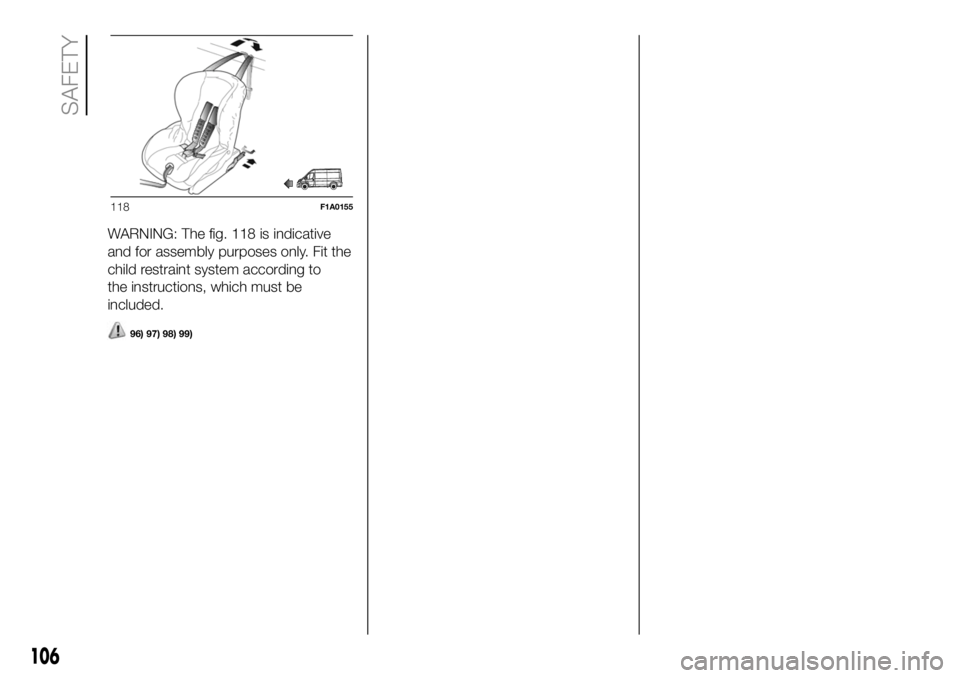
WARNING: The fig. 118 is indicative
and for assembly purposes only. Fit the
child restraint system according to
the instructions, which must be
included.
96) 97) 98) 99)
118F1A0155
106
SAFETY
Page 109 of 304
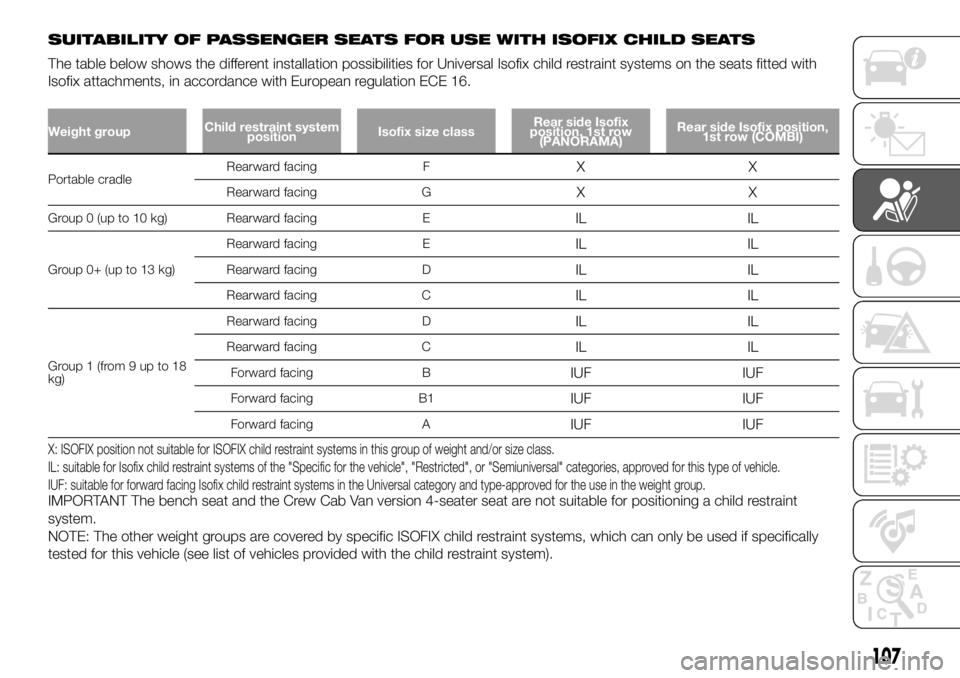
SUITABILITY OF PASSENGER SEATS FOR USE WITH ISOFIX CHILD SEATS
The table below shows the different installation possibilities for Universal Isofix child restraint systems on the seats fitted with
Isofix attachments, in accordance with European regulation ECE 16.
Weight groupChild restraint system
positionIsofix size classRear side Isofix
position, 1st row
(PANORAMA)Rear side Isofix position,
1st row (COMBI)
Portable cradleRearward facing FXX
Rearward facing GXX
Group 0 (up to 10 kg) Rearward facing EIL IL
Group 0+ (up to 13 kg)Rearward facing E
IL IL
Rearward facing DIL IL
Rearward facing CIL IL
Group1(from9upto18
kg)Rearward facing D
IL IL
Rearward facing CIL IL
Forward facing BIUF IUF
Forward facing B1IUF IUF
Forward facing AIUF IUF
X: ISOFIX position not suitable for ISOFIX child restraint systems in this group of weight and/or size class.
IL: suitable for Isofix child restraint systems of the "Specific for the vehicle", "Restricted", or "Semiuniversal" categories, approved for this type of vehicle.
IUF: suitable for forward facing Isofix child restraint systems in the Universal category and type-approved for the use in the weight group.
IMPORTANT The bench seat and the Crew Cab Van version 4-seater seat are not suitable for positioning a child restraint
system.
NOTE: The other weight groups are covered by specific ISOFIX child restraint systems, which can only be used if specifically
tested for this vehicle (see list of vehicles provided with the child restraint system).
107
Page 110 of 304
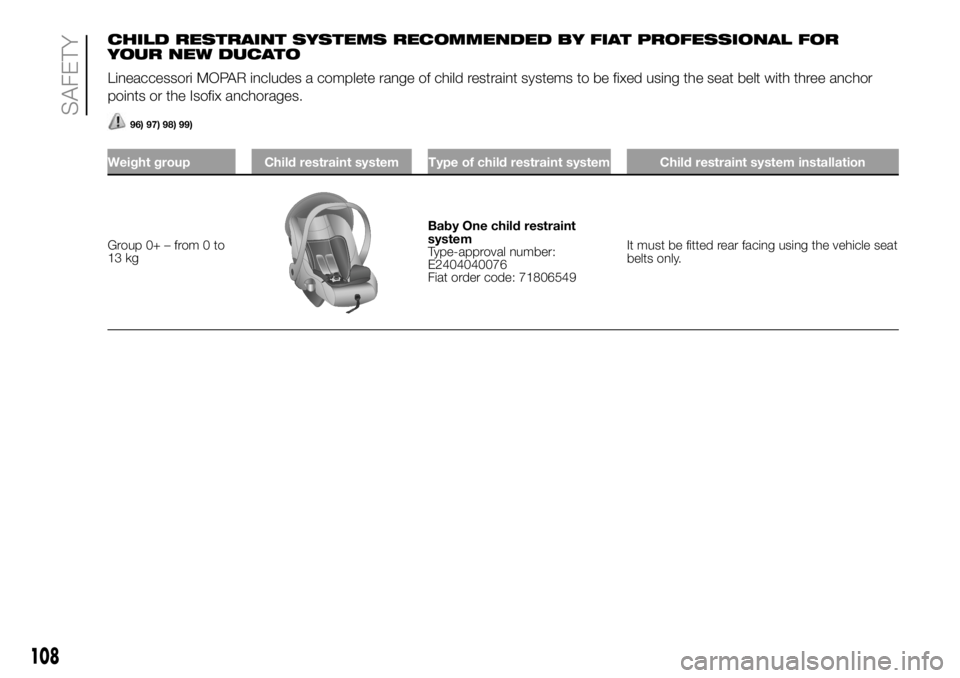
CHILD RESTRAINT SYSTEMS RECOMMENDED BY FIAT PROFESSIONAL FOR
YOUR NEW DUCATO
Lineaccessori MOPAR includes a complete range of child restraint systems to be fixed using the seat belt with three anchor
points or the Isofix anchorages.
96) 97) 98) 99)
Weight group Child restraint system Type of child restraint system Child restraint system installation
Group 0+ – from 0 to
13 kg
Baby One child restraint
system
Type-approval number:
E2404040076
Fiat order code: 71806549It must be fitted rear facing using the vehicle seat
belts only.
108
SAFETY